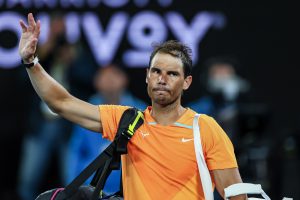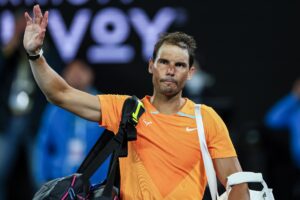The sporting world witnessed a brilliant year of Grand Slam tennis in 2021. History was made. However, not the history we were expecting, with Daniil Medvedev popping Novak Djokovic’s Grand Slam balloon. Instead, a “NextGen” player was finally crowned Grand Slam champion.
This was a long time coming but men’s tennis looks set to move forward into a new decade. A decade where younger players will be fighting it out for major honors. This doesn’t mean Novak Djokovic is finished winning Majors, but the Next Gen maybe ready to take over.
Traditionally in men’s tennis, the baton is passed soon after a decade begins. In the early 1980s, John McEnroe and Ivan Lendl wrestled control of the #1 position from Bjorn Borg and Jimmy Connors. McEnroe made the jump first, then Lendl soon followed, eventually winning his first French Open in 1984. This after appearing in three finals at the French Open and US Open. Ten years later, Jim Courier became number 1 in 1992 after winning two Australian Opens and two French Opens, followed by Pete Sampras soon afterwards.
Into the early 2000s, with Marat Safin, Gustavo Kuerten then Lleyton Hewitt assuming control from Sampras and Agassi. Then Roger Federer took over Hewitt at the beginning of 2004. And as the 2010s progressed, Djokovic took control from Federer and Nadal in 2011. Although in Djokovic’s case, his tug of war with Federer and Nadal would last the entire decade.
It seems we have been waiting for ages for a new generation to take over; they have been coming but were yet to arrive.
2021 has proven to be an intriguing year involving an almighty tussle between the Next Gen and one man, Novak Djokovic. Djokovic did his level best to hold them off single-handedly. In any other era, Djokovic would either be long retired or out of theGgrand Slam conversation at the age of 34. Instead, Djokovic was going for the Calendar Grand Slam and Olympic Gold.
That Calendar Slam quest started in January. Djokovic saw off Medvedev in three easy sets in Australia, the first “NextGen” player seen off. Then in June Tsitsipas was the next “NextGen” man to attempt to deny Djokovic and create his own history. It looked like it was on with Tsitsipas taking a two-set lead in the French Open final. But it was not to be, Djokovic roaring back to take it in five.
Two NextGen finalists? No problem
One month later and the Wimbledon final, this time the opponent being Italy’s Matteo Berretini. Djokovic again lost the first set on a tiebreak but came back to win in four sets. Three Next Gen players downed, with one to go.
Who would that player be? Djokovic defeated another “Next Genner” Shapovalov in the semifinal of Wimbledon. He was beaten by Alexander Zverev in the Olympic semifinal. There were Next Gen guys everywhere to deal with.
The answer became clear enough. We knew Djokovic would be in the US Open final so it was a question of who will join him. That player was #2 seed Medvedev, the current best hard court player in the world. The memo was that Djokovic was a little mentally and physically fried after it went badly wrong at the Olympics. But no one could have predicted the beating Djokovic would receive in the US Open final. It reminded me of the year 2000 when another tall Russian Marat Safin shocked the world beating Pete Sampras also in three sets. Djokovic didn’t achieve the holy grail of the calendar grand slam but gained a whole new army of fans. Which left him emotionally drained and a warm feeling inside.
The real story has to be that the NextGen has arrived. Djokovic will be around to win more Majors but the NextGen collectively will take comfort in what Medvedev achieved. Medvedev was the one to kick in the door, so it is now up to the rest to walk through and claim history for themselves going forward.
And, who will be the contenders over the upcoming ten years in the majors? As of now, the outright favourites are Daniil Medvedev, Stefanos Tsitsipas, Alexander Zverev, Denis Shapovalov and Matteo Berretini. Just below those guys include Félix Auger-Aliassime, Jannik Sinner, Lorenzo Mussetti, and a certain Carlos Alcaraz. Then there are “wildcards” such as Hubert Hurkacz who could do some damage somewhere if he can acquire more self belief.
The thing here is these players all have technical flaws in one way or another. Perhaps this is what makes this generation so interesting. It is difficult to see one player breaking out from the pack to win 15+ Majors. They are all well matched, but that’s not to say it couldn’t happen.
One scenario could be that we get a 1980s situation where six players share out the Majors. From the mid 1970s to mid 1990s Connors and Lendl won eight, McEnroe and Wilander won seven, and Becker and Edberg won six.
Thus far, Medvedev has shown he can only play on hard courts and Tsitsipas plays his best on clay. Shapovalov does not control his shots or emotions while Zverev has proven to be incredibly mentally challenged at major level. Zverev has lost ten straight matches against top 10 players in slams.
But that could be the scenario to breathe new life into men’s tennis which in my eyes has gone stale over the last few years, despite the media’s obsession with the “Big Three”.
Danill Medvedev made the first move. It’s time his contemporaries followed into a new era of exciting tennis.
Main Photo from Getty.






